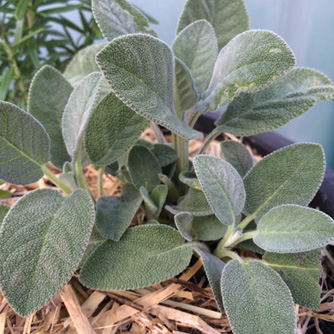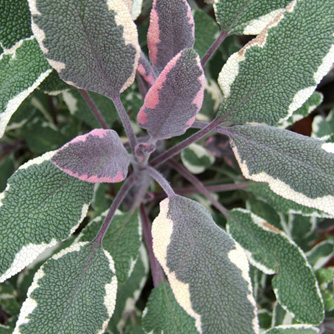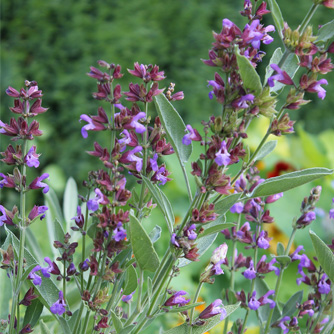Sage
BackSage (Salvia officinalis) is a sensational herb renowned for its healing and antiseptic properties that has many uses. You’ll find it in toiletries such as perfumes, soap and even pot pourri. In cooking it is a lovely addition to stuffing for chicken and meats as well as in egg and vegetable dishes.
Sage is a hardy perennial with greyish leaves and unusual square stems (a characteristic of all salvias). Flowers are usually lilac or purple but can be also pink or white. Plant it on the edge of your veggie patch to help attract bees or simply use it to jazz up a hot, dry spot in the garden.
There are several different sage cultivars including one with golden leaves and one with purple tinged foliage. There’s also the lovely sage ‘Tricolour’ which has green and cream leaves that are tinged purple and pink. There are also other types of edible sage, like pineapple sage (Salvia elegans), but this page is just about common sage (Salvia officinalis).
How To Grow Sage
Sage is another Mediterranean herb that needs a full sun position and doesn’t like summer humidity or wet feet. Good drainage and air circulation are essential to keep plants healthy. Sage is often grown in pots, especial in humid coastal regions, where it performs well due to the extra drainage and air flow.
Sage will grow in very poor soils but improving the soil with compost and manure beforehand will enhance its growth. Boost calcium levels by applying dolomite or lime to mimic Mediterranean soil conditions.

Common sage
Usually people just buy a sage plant from the nursery to get started but it can also be grown from seed. Sow seeds direct in spring (after frosts) and summer and they’ll germinate in 3-4 weeks. Our preference though is to just strike cuttings from established plants in spring and summer. It’s easier and faster as they’ll be ready to pick leaves from in a month. Either way water in seeds or cuttings with OCP eco-seaweed to improve your success rate and mulch lightly.
Sage often produces new plants by itself from branches that layer onto the soil and take root. These can be easily cut off and make great transplants.
Fertilising & Pruning Sage
Sage will appreciate an application of dolomite or lime once or twice a year to boost calcium levels. You can also apply a mixture of OCP eco-seaweed and OCP eco-aminogro each month to ensure fabulous flavour in the leaves and keep your sage growing to its maximum potential.
On the pruning front sage doesn’t really need much attention. Trim back the flower spikes once they’re finished in summer and that’s about it. Pretty low maintenance don’t you think?
Harvesting Sage
Pick individual leaves throughout the growing season as you need them. These can be used fresh or allowed to dry and stored for later use.

Sage 'Tricolour' with variegated leaves
Pests & Diseases of Sage
Sage is generally an easy care herb but there are a few problems which can crop up from time to time:
- Caterpillars – pick off by hand before they do too much damage or spray with OCP eco-caterpillar killer.
- Powdery mildew – Remove infected leaves and spray with an organic fungicide as required. Increase airflow around plants and minimise overhead watering to keep the foliage dry.
- Aphids, mites, whitefly and mealybugs – if any of these sap suckers appear spray with a horticultural oil and repeat spray as needed.

Sage in flower


